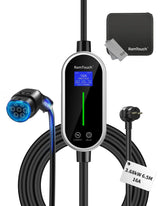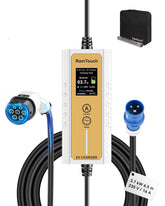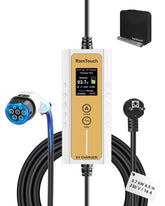Why Your EV Doesn’t Charge at Full Speed
Why Your EV Isn’t Charging at Full Power?
Understanding EV Charging Speed & How to Get the Best Performance
Many EV owners are surprised when their vehicle doesn’t charge at the maximum advertised kW — especially after purchasing a portable EV charger that claims high power output.
But in most cases, this isn’t a malfunction. Instead, it’s your EV’s battery management system (BMS) working to protect your battery’s health and extend its lifespan.
Here’s what every EV owner needs to know to get the most from their charger — especially in real-world conditions.
🔋 1. Battery State of Charge (SOC): The #1 Factor Affecting Charging Speed
EV charging doesn’t happen at a flat rate — it follows four main stages:
Trickle Pre-Charge → Constant Current → Constant Voltage → Trickle Float
Let’s break this down by SOC level:
-
Low SOC (<20%): Charging begins cautiously. The BMS applies a low current trickle charge to safely start the process.
-
Optimal SOC (20%–50%): ✅ This is the sweet spot! Your EV will most likely draw maximum charging power here — using constant current mode.
-
High SOC (>80%): As the battery nears full, the BMS shifts to constant voltage, reducing current to avoid overcharging.
-
Near Full (~100%): Charging slows dramatically, entering a float mode — barely drawing power.
⚠️ Start charging from 70% or higher? You may never see the maximum advertised power, because you’re skipping the peak efficiency range.
✅ Tip: For the fastest results, charge when your battery is between 20%–50%.
❄️ 2. Cold Weather Charging: Why Your EV Slows Down in Winter
Temperature has a huge effect on charging — especially for portable EV chargers used outdoors or in unheated garages.
When it’s below 10°C (50°F), here’s what happens:
-
Your BMS prioritizes warming up the battery, not fast charging
-
Initial power draw may be just 20%–30% of the peak
-
It can take 10–30 minutes before the battery warms enough to allow full-speed charging
It’s not your EV charger’s fault — it’s your car protecting its battery.
✅ Tip: In winter, precondition your battery (many EVs allow this via app) and be patient with fast charging.
⚡ 3. Other Factors That Affect EV Charging Speed
Even if your portable EV charger supports 7kW or more, charging speed still depends on:
-
Your EV’s onboard charger (many limit AC charging to 6.6kW or less)
-
Cable quality — Thicker cable (lower gauge) = better conductivity
-
Charger temperature — overheating may cause throttling
Always use certified EVSE (electric vehicle supply equipment) designed for your region, and follow manufacturer guidelines.
✅ Conclusion: It’s Not Always About the Charger
If your EV isn’t charging at full speed, don’t worry.
Your vehicle’s smart system is:
-
Protecting the battery
-
Reacting to temperature
-
Responding to your battery’s current state of charge
👉 Here’s how to improve your EV charging experience:
-
✅ Charge between 20%–50% SOC for peak efficiency
-
✅ Use a high-quality portable EV charger with proper power support
-
✅ Precondition your EV in cold weather
-
✅ Understand your EV’s onboard limitations















